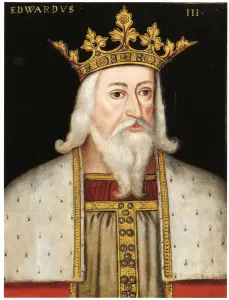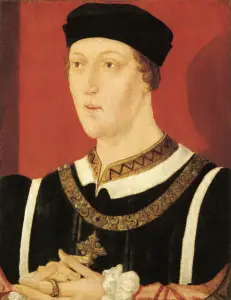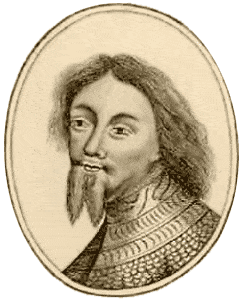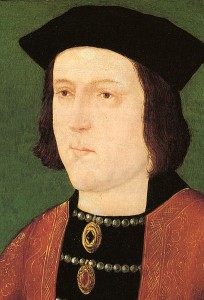
On this day in history, the 22nd August 1485, the Battle of Bosworth (or Battle of Bosworth Field) took place in Leicestershire, England. The battle took place during the Wars of the Roses, a civil war between the Houses of York and Lancaster, and is famous for being the battle which gave birth to the Tudor dynasty. It was also the last time that a King of England was killed in battle.
The Wars of the Roses
Between c1455 and 1485, England was torn apart by the Wars of the Roses, a dynastic civil war between two branches of the House of Plantagenet: the House of York and the House of Lancaster, who both believed they had claims to the English throne as they were both descended from Edward III. Obviously, I could write a book about the Wars of the Roses, but here I just want to give a brief overview to give you the context for the Battle of Bosworth. I realise I’ve missed lots out so I apologise in advance!
The House of Lancaster

The Lancastrian claim to the throne came from Edward III’s fourth son, John of Gaunt, 1st Duke of Lancaster. In 1399, John’s son, Henry of Bolingbroke, deposed his cousin, Richard II (son of Edward, the Black Prince, eldest son of Edward III), became King Henry IV and established the Royal House of Lancaster. On his death in 1413, the crown passed to his son Henry V who subsequently passed the crown on to his son, Henry VI, on his death in 1422. Henry VI, however, was mentally unstable, so some of his nobles allied themselves with the Duke of York, Richard Plantagenet, who was looking to act as regent and ultimately take the throne.
The House of York
Richard, Duke of York, was descended from the second son of Edward III, Lionel of Antwerp, through his mother, Anne Mortimer, and from the fifth son of Edward III, Edmund of Langley, 1st Duke of York, through his father, Richard of Conisburgh. Although Richard’s father had been executed as a traitor in the reign of Henry V, Richard had been allowed to inherit his title and lands from his uncle, Edward of Norwich, 2nd Duke of York, who was killed at the Battle of Agincourt. His inheritance enabled him to become the richest and most powerful noble in England.
Civil War

Henry VI’s mental problems led to great social unrest and his policy of peace with France also made him unpopular with some of his nobles, including the Dukes of Gloucester and York. In 1445 Henry VI married Margret of Anjou and, as part of the Treaty of Tours, yielded the lands of Maine and Anjou to the French king, Charles VII, a move that was hugely unpopular. As Henry’s reign went on, he became increasingly unpopular, due to the economic situation in England, the corruption in his government and his policy of peace with France.
In 1452, disaffected nobles called Richard, Duke of York, back from Ireland (he had been made Lieutenant of Ireland to keep him out of the way) and begged him to put a stop to what was going on in England and make a stand against Henry VI and his government. To cut a rather long story short, Richard, was able to take control of England as Protector of the Realm (regent) in 1454 after Henry VI had a nervous breakdown, but it was shortlived as Henry recovered at Christmas 1454 and set about reversing all of Richard’s policy and good work. However, many nobles supported Richard’s regency and this led to a war between Henry’s house, the House of Lancaster, and Richard’s house, the House of York. Richard was killed in one of the battles of the Wars of the Roses, the Battle of Wakefield in December 1460, but just weeks after his death, his son, Edward, Earl of March, was crowned King Edward IV of England after defeating the Lancastrians in a succession of battles, supported by his cousin, Richard Neville, 16th Earl of Warwick (Warwick the Kingmaker).

To cut another long story short, Edward IV fell out with Warwick (the Kingmaker) and this led to Warwick plotting against Edward and supporting the claims to the throne of George, Duke of Clarence (Edward’s younger brother), and then Henry VI. Henry was briefly restored to the throne in 1470 but this was shortlived as Edward was able to claim the throne back in 1471 after taking Henry prisoner, defeating and killing Warwick at the Battle of Barnet and then defeating the Lancastrians at the Battle of Tewkesbury. Henry VI died in May 1471, although it is not clear whether he died naturally or whether he was murdered on Edward IV’s orders.
In 1483, Edward IV died unexpectedly. His brother, Richard, Duke of Gloucester, was appointed Lord Protector to act as regent for Edward’s son, Edward V, who was just a child. To cut another long story short, Edward IV’s marriage to Elizabeth Woodville was deemed to be invalid, thus making the claims of their sons, Edward and Richard, to the throne invalid, and Richard seized the throne becoming Richard III. The boys, who were lodged in the Tower of London, disappeared and it is not known what exactly happened to them.
In 1483, Henry Stafford, 2nd Duke of Buckingham, rose up against Richard III, planning to replace him with Lancastrian, Henry Tudor, but the revolt was unsuccessful and Buckingham was executed as a traitor. In 1485, Henry Tudor, 2nd Earl of Richmond, and his uncle, Jasper Tudor, rebelled against Richard. Henry’s claim to the throne came through his mother, Margaret Beaufort, who was a great-granddaughter of John of Gaunt, Duke of Lancaster, and in 1485 he was the senior Lancastrian claimant because Henry VI and his son, Edward, Prince of Wales, were both dead. On Christmas Day 1483, in Rennes Cathedral, France, Henry pledged to marry Elizabeth of York, daughter of Edward IV and the sister of the Princes in the Tower (Edward V and his brother Richard), thus gaining more support for his claim to the English throne. Henry also had the support of the Welsh, being descended through his father, Edmund Tudor, from Rhys ap Gruffydd, The Lord Rhys.
Find out what happened when Henry and his 5,000 soldiers marched from Wales to England in The Battle of Bosworth 1485 Part 2 – The Battle.
Wonderful short version of the Wars of the Roses. Thanks !
Just turned the last page on Philippa Gregory’s The Red Queen, the story of Margaret Beaufort, Henry VII’s mother. If this book is accurate, she was a very unpleasant person, and I was glad to leave her company. Sounds like art imitates life, because Gregory’s The White Queen about Elizabeth Woodville was the portrait of a lively, attractive, imaginative person. Both of them were very ambitious and very active in the interests of their family and house during turbulent times. Grand dames, indeed.
I haven’t read this book, but of what I know (ie very few)about Margaret Beaufort’s temper is her reputation as being very pious and decent.
Of course her life had been rather a sad one ; she lost her father nearly at birth.
And her mother married (for the third time) soon after.
Margaret herself, taking descent from a royal prince (but by a relation with a hwoman of low condition, Catherine Swynford), could find no steady protector.
That might explain her own very soon first wedding to a Tudor (born outwed).
We have to remember she was about thirteen by then.
Mother of one (H VII to-be ), widowed at fifteen, she certainly knew the meaning of the “struggle for life”, and she probably had to act with the utmost energy and her moral strength must be counted as a virtue – as we know, by the time, wars were everlasting and it was a matter of life or death not to show the behaviour of a weak, sentimental sheep .
Her future daughter-in-law Elizabeth Plantagenet by contrast, began her life as a rather spoilt royal princess .
Her own marriage however doesn’t appear as a very romantic one; after the failure of her famiily, she was anxious to find a strong protector.
This one just needed a true royal to settle some royal titles, even if not in his own right
I’m pretty sure that we know few about Margaret beaufort’s temper for she began to lead a discrete life, ignored by biographs (not interested in a the fate of a grand-daughter of a royal bastard).
But we can see with her success, and how she bred her only son, that her will and strength were exceptional – so she surely was a very high-spirited woman in fact.
Just to say – I guess it’s very uneasy to judge a character of these times according to our nowadays standards
Thanks, once again I have enjoyed reading all about our turbulent past. Wonder if the mystry of the poor young princes will ever be solved.
I thought it was determined that the skeletons found in the stairwell were the princes. If anyone knows we’d love to hear.
Nobody knows as they haven’t ever been examined properly using modern technology. The urn hasn’t been opened since they were interred in the 17th century.
I think the likelihood that they are the princes is very high, Sir Thomas More wrote that they were buried beneath the stairwell and that’s where they were found, no other boys are recorded as being lost in the Tower, I think out of all the stories of the Towers victims, the two princes are the most saddest of all.
Thomas More also said they were moved from the stairs. The depth they were found is ten feet down, at the pre Medieval level.
Several so called boys bones have been found at the Tower. They were also never held in the White Tower.
In 1647 two children were found, claimed to be the Princes. In the reign of Elizabeth I bones were identified vas the Princes. In Victorian times they identified bones which turned out to be an ape.
The sex of the bones and age has never been conclusively confirmed. The bones were found with other bones, chicken, pigs, horse, duck, many other animals, possibly representing an Iron Age Burial. Bones were found of several humans in 1932, some were again claimed to be the Princes.
We believe the bones are of two Princes from 1674 because that was the claim, without anything scientific to back it up. The skeletons are not even complete. Charles ii had them buried as the Princes and the 1933 examination pre supposed they were the Princes. The conclusions were not as conclusive as most people think and crucially they could not confirm the sex because they had no DNA and the factors of diet, genes and age made this difficult. Various findings have since been challenged.
Thomas More said that the bodies were moved and given a proper burial elsewhere so any bones found on the stairs would not be the Princes.
There is very little evidence that these boys were killed by anyone let alone Richard iii who had no motive, as they were illegitimate. Henry Tudor found nothing, dead or alive. If they did die it could just as easily have been natural causes, disease or at the hands of Buckingham who could have used them in his easily put down rebellion. They could have lived into the next reign, here or abroad. There is just as much evidence for their survival as their deaths. Sad as the myth is, it’s a myth. They weren’t even prisoners. They were Royal wards. At first Edward was there as it is the official residence of the Sovereign until he ceased to be King on 26th June 1485. Even then he and Richard, who was practically a stranger to him, were housed in another part of the palace, not the White Tower. The building was next door. They had medical care and the accounts show sumptuous food and robes being ordered for them in July 1485. They were spotted as late as September 1485. They were also known to have received regular visits from their doctor and there is evidence that at least one was alive in 1484. They could have been moved and numerous people believed Richard of England in 1491 to 1499 to be who he claimed to be, Richard, Duke of York.
I am not saying they definitely were not killed, just that there is no real evidence and we have to consider other potential outcomes. The only thing we know for certain is the two boys, never called the Princes in the Tower, until the late nineteenth century, disappeared, later presumed dead. It is highly unlikely that the bones passed of as them in 1674 are those lost boys. A new scientific investigation is needed. Now we have DNA profiling, we have a line of female descendants from Elizabeth Woodville to compare and we have Richard iii’s DNA. Now we can sex the children, age them and say when they died and how, within reason. We can’t say who if they were killed. Now we can also say definitely if they are related. Much of this was guessed at and some questions could not even be answered in 1933 by Tanner and Wright so it’s time to open up the Urn and give them an identity if we can. No matter who they are it is sad that they died young. Until we have modern evidence the real fate of former Edward V and Richard, Fourth Duke of York remains a mystery.